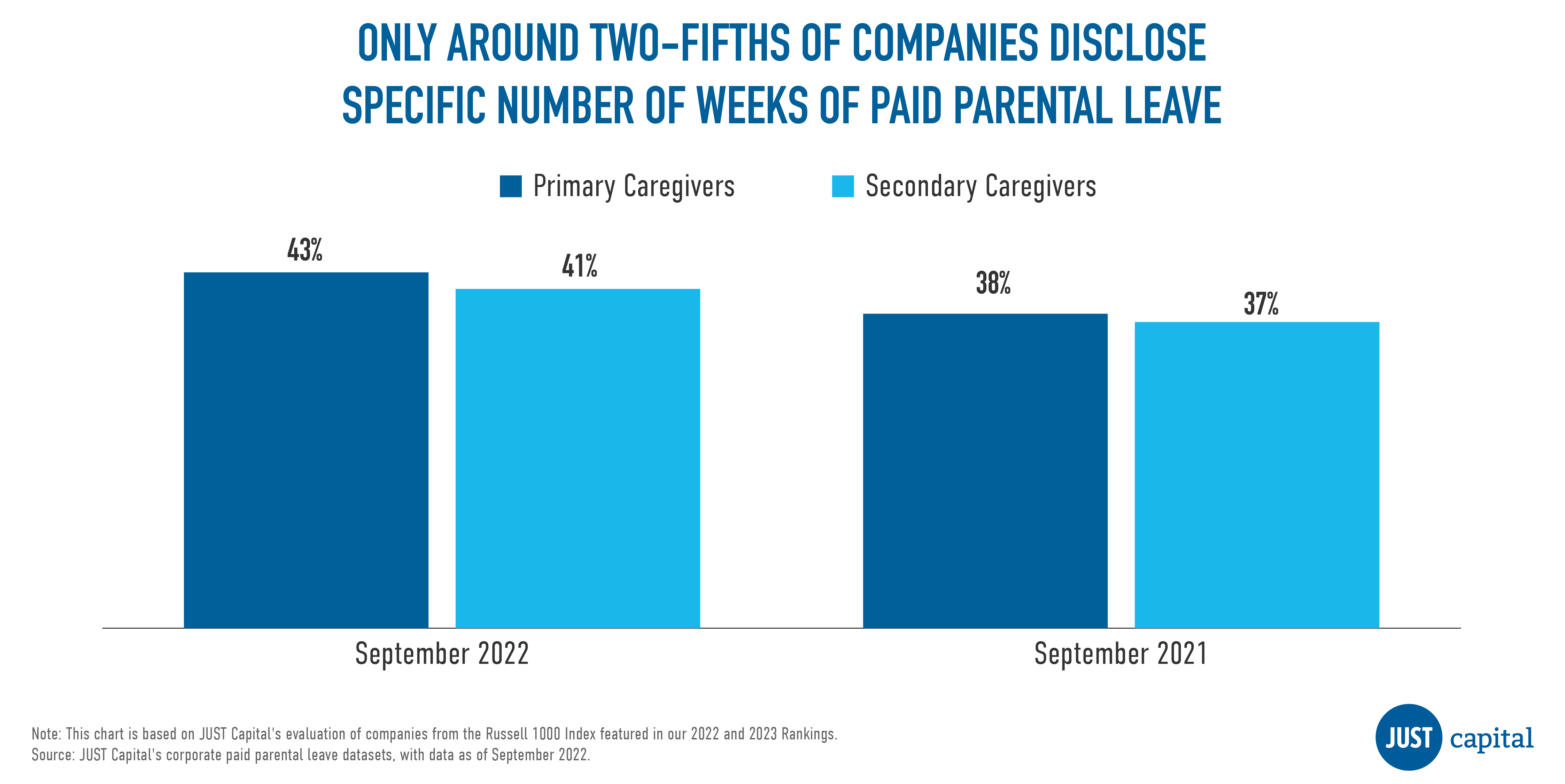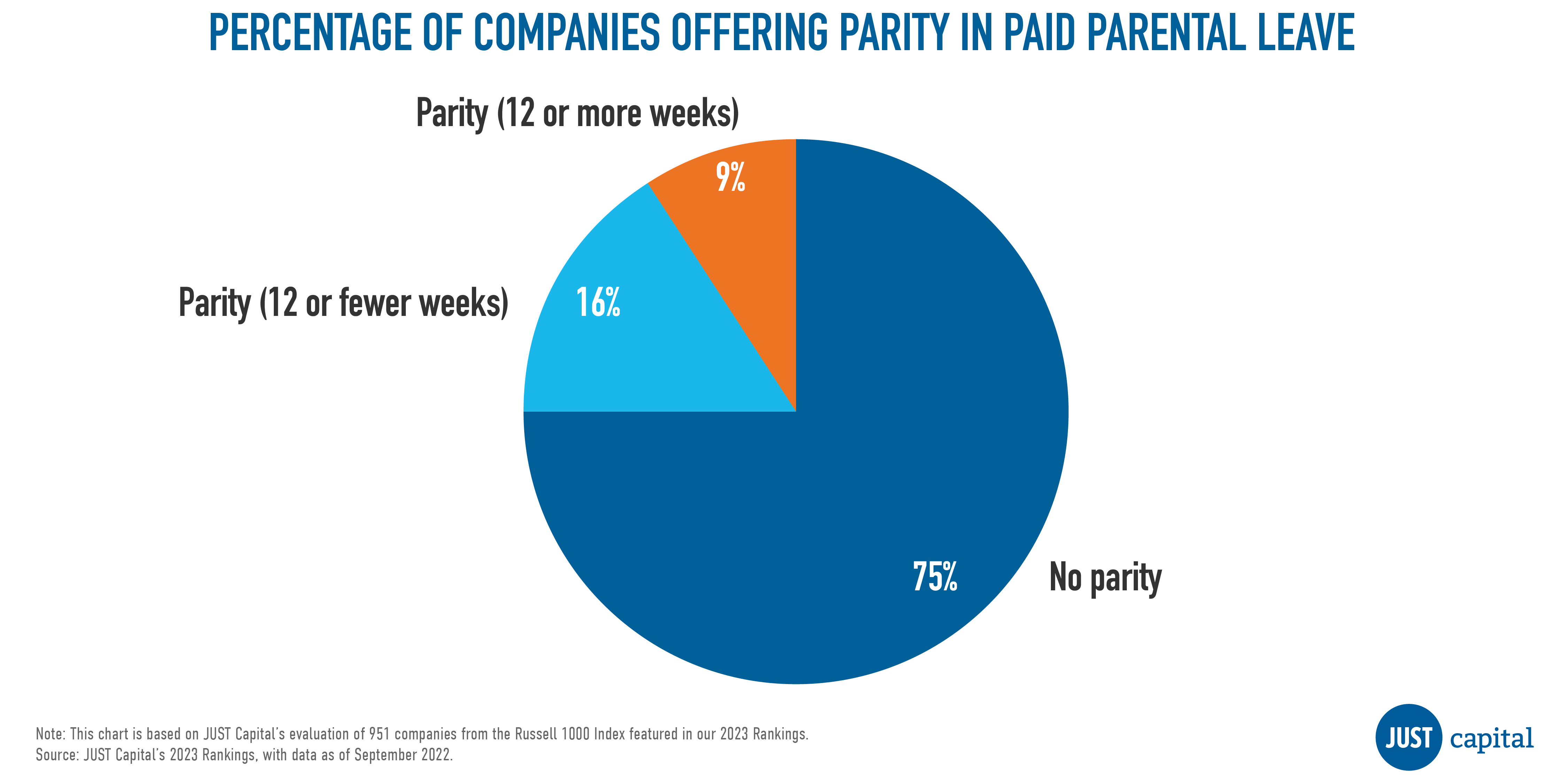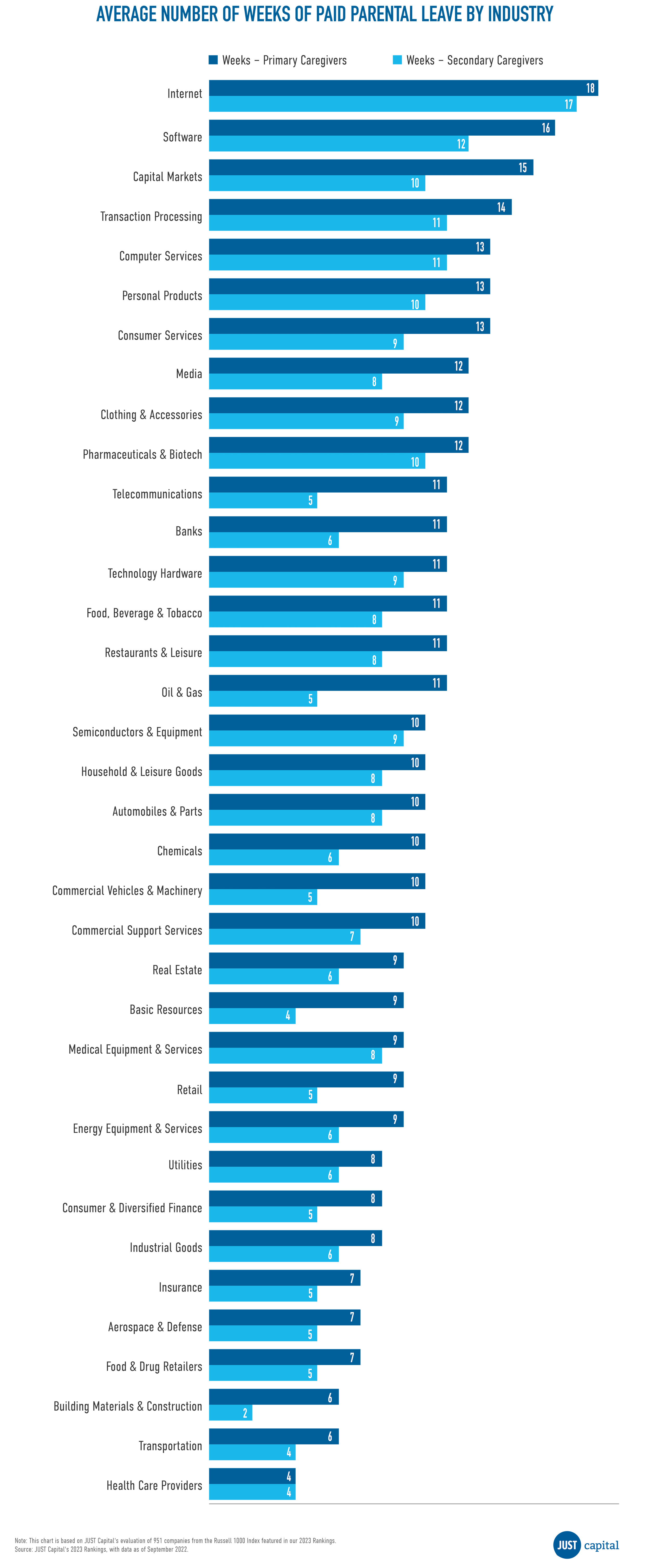JUST Report
Only 9% of America’s Largest Companies Provide Parity in Paid Parental Leave of 12+ Weeks for Primary and Secondary Caregivers
- More Reports
- View all JUST Reports

(Andresr/Getty Images)
This report was written by Jordyn Avila, Senior Strategic Partnerships Manager, Corporate Impact, and Matthew Nestler, Director of Research Insights, Corporate Impact.
Key Takeaways
- Disclosure of a paid parental leave policy is increasing. As of September 2022, 60% of America’s largest public companies disclose a paid parental leave policy, compared to 47% the year before.
- However, fewer companies disclose the specific number of weeks of paid leave for primary and secondary caregivers. Only around two-fifths of companies disclose these details as of September 2022.
- Parity in paid parental leave is low, but slightly higher than last year. The share of companies disclosing equal paid leave for both primary and secondary caregivers of at least 12 weeks is low (9%, or 87 companies), but is up slightly compared to the year before (6% of 59 companies). These policies cover around 1.5 million American workers.
- Nine of the 36 industries we track saw 50% of companies disclosing the specific number of weeks for both primary and secondary caregivers – with standouts including Oil & Gas, Internet, Transaction Processing, and Banks.
- Of the companies that disclose the number of weeks, those in the Internet industry lead with an average of 18 weeks for primary caregivers and 17 weeks for secondary caregivers, followed by Software (16 and 12), and Capital Markets (15 and 10).
In recent years, the COVID-19 pandemic has exposed the severity of America’s ongoing childcare and caregiving crises – with a recent analysis showing that 22% of American workers are also caregivers. Reports suggest that the childcare industry continues to deteriorate, exacerbating the obstacles that working parents already face in achieving work-life balance, including the lack of federally mandated parental leave.
In a recent JUST Capital survey, we found that 64% of Americans believe that in order to promote gender equity in the workplace, it is necessary for companies to provide at least 12 weeks of paid parental leave to all workers.
Despite strong support from the public, there is no guaranteed paid leave for the American workforce. The United States is one of just seven countries in the world without paid maternity leave and one of 83 without paid paternity leave. In the U.S. today, only the Family and Medical Leave Act (FMLA) provides eligible employees up to 12 weeks of unpaid leave per year, compared to an average of 29 and 16 weeks of paid maternity and paternity leave, respectively, among countries with mandated parental leave. Furthermore, just 56% of American workers have been found to be eligible for FMLA leave, with numbers even lower for people of color and low-wage earners. As of January 2023, 13 states and Washington DC offer paid parental leave (with five policies not yet in effect), though not all offer the 12 weeks Americans agree are necessary.
Due to this lack of governmental support, it’s largely up to companies to take the lead on paid parental leave. And with just 23% of civilian workers estimated to receive paid family leave – and only 12% of low-wage earners in the private sector – the need for action is urgent. Furthermore, paid parental leave is not only beneficial for working families. Because it provides opportunities for increased labor force participation and potential GDP increases, as well as improved employee performance, paid parental leave can strengthen companies and the economy overall.
In an effort to better understand how corporate America is currently delivering on this issue, we analyzed whether America’s largest companies – the Russell 1000 – disclose paid parental leave policies, and if so, what that disclosure looks like. This analysis is part of our new Corporate Care Network – which will explore how companies are supporting working families and spotlight best practices from corporate leaders taking the lead on issues from subsidized child care to paid parental leave. Dig into the full findings below.
The Current State of Paid Parental Leave Disclosure Among Russell 1000 Companies
In analyzing the Russell 1000 companies we rank, we found that 60%, or 568 companies, disclosed a paid parental leave policy as of September 2022 – a 13 percentage point increase over the year prior when 47%, or 444 companies, disclosed.
While this increase is heartening, when we look closer at the data we find that far fewer companies disclose the specific number of weeks offered to primary and secondary caregivers, with 43%, or 408 companies, providing the number for primary caregivers and 41%, or 388 companies, disclosing the same for secondary caregivers. We did find that, like the overall disclosure percentages, these numbers also increased over the past year, with 47 more companies disclosing the number of weeks for primary caregivers (38% to 43%) and 36 more disclosing for secondary caregivers (37% to 41%).

The benefits of paid parental leave are significant for both primary and secondary caregivers. Study after study shows that access to paid leave leads to better health outcomes for both mothers and children. It’s also been found that when men take paid leave, we see lower divorce rates, closer relationships between fathers and children, and lower rates of postpartum depression and other maternal health issues. With growing support for equitable weeks of paid parental leave, disclosure of specific weeks for both primary and secondary caregivers is a critical first step for corporate leaders looking to drive change on this issue overall.
Parity in Weeks of Paid Leave for Primary and Secondary Caregivers at or Above 12 Weeks
While disclosure itself is key to understanding the current landscape of paid parental leave, it is increasingly considered a corporate best practice to offer parity in paid leave for both primary and secondary caregivers. Leading to better outcomes for workers and their families, parity in paid leave is a more inclusive practice, acknowledging all family types and the roles that parents play in childcare, regardless of their gender identity, relationship status, or sexual orientation.

To assess how companies perform, we look at how many provide parity in leave at or more than 12 weeks. As of September 2022, 9%, or 87 companies, provide equal weeks of paid leave to primary and secondary caregivers, compared to 6%, or 59 companies, a year earlier – an increase of 3 percentage points and 25 companies.
Paid Parental Leave Disclosure by Industry
Among the 36 industries we analyze, none demonstrated full disclosure, in which all companies disclosed the specific number of weeks of paid leave for both primary and secondary caregivers. Just nine of these 36 industries had a disclosure rate above 50%, though there were some standouts. Of the 25 companies in the Oil & Gas industry, 72% disclosed the weeks of paid parental leave offered to both primary and secondary caregivers, closely followed by the Internet industry with 67% of companies disclosing, Transaction Processing (65%), and Banks (63%).
16 industries have a disclosure rate between 30% and 50%, representing 196 companies that disclose the number of weeks of paid leave for both primary and secondary caregivers. However, nine industries fell below the 30% disclosure rate.

Based on these findings, there is a clear opportunity for Russell 1000 companies – particularly in certain industries – to not only disclose that they offer paid parental leave, but the number of weeks they provide.
Average Number of Weeks of Paid Parental Leave by Industry
In looking at the policies of companies that disclose the number of weeks of paid leave, we found that primary caregivers receive between one and 26 weeks, with a mean of 10.5 weeks, and a median of 10 weeks. Secondary caregivers also receive a range of one to 26 weeks, but the mean and median are 7.6 weeks and six weeks, respectively. As a way to further assess performance, we quantify the average number of weeks of paid parental leave for both primary and secondary caregivers by industry. The highest performing industry is Internet, offering 18 weeks on average for primary caregivers and 17 on average for secondary caregivers. Software is also leading by offering an average of 16 and 12 weeks to primary and secondary caregivers, respectively.

Although our JUST Jobs Scorecard awards the highest score (4/4) to companies offering 24 weeks or more of paid parental leave, this analysis reveals that 10 industries offer an average of 12 or more weeks of paid parental leave for primary caregivers, while only two offer the same for secondary caregivers. 26 industries offer, on average, fewer than 12 weeks of paid parental leave for primary caregivers and 34 offer the same, on average, for secondary caregivers. For primary caregivers, 15 industries offer between 10 and 12 weeks on average, and for secondary caregivers, 17 industries offer between 4 and 6 weeks.
Only Health Care Providers offered an equal average amount of leave for primary and secondary caregivers. All other industries provided more weeks of paid parental leave to primary caregivers.
While our latest analysis signals that corporate America is steadily improving its efforts around paid parental leave, millions of workers around the U.S. do not have access to paid parental leave to welcome home their newest family member, to recover from a birth event, and to adjust to life with a new child. Women, people of color, and individuals who identify as LGBTQ are least likely to have access to paid leave, exacerbating racial and gender inequities in workplaces. Without a federal mandate or policy, workers of all types rely on the private sector to ensure that they have access to adequate paid parental leave, a key benefit for companies to improve retention, attract talent, and strengthen employee health and wellness and engagement.
JUST Capital, in collaboration with partners, established the Corporate Care Network to advance the well-being of workers and demonstrate the long-term value of investment in workers. The Network is committed to driving increased access to care benefits, including paid family and medical leave and flexible work policies.
If you’re interested in learning more on how your company can become involved, please reach out to JUST Capital at impact@justcapital.com.